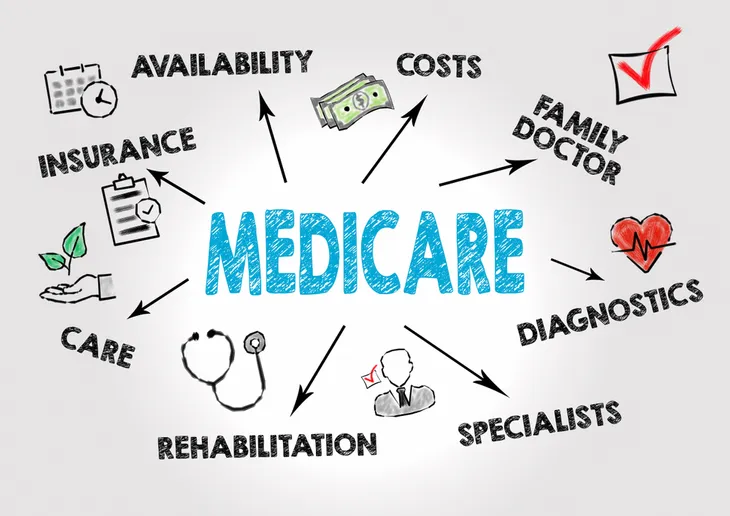It’s extremely important for Americans to learn about any potential changes happening to Medicare, particularly seniors. Many seniors purchase Medigap plans to help pay for those extra services they need that their Medicare Part A and B do not fully cover. In the upcoming 2020, there will be some substantial changes.
The biggest change is happening to Medigap Plan F and C, but there are some other notable changes that will occur too, including increases to Part B premium, Part B deductible, Medicare Advantage enrollment, and more. To stay informed on all these important changes, keep reading. We’re created a detailed list of all the 2020 changes every American should know.
1. Changes to Medigap Plan F and C
Arguably the biggest change to Medicare in 2020 will be to Medicare Supplement Plan F. This is the most popular because according to eHealth Medicare, it offers the most comprehensive list of basic benefits out of all the other Medicare Supplement policies. This supplement plan essentially covers all of the costs left over after the Original Medicare (Part A and Part B) has been paid out. This means enrollees have fewer out of pocket expenses. It’s main goal is to fill any gaps in Medicare coverage.
Despite being around for decades and being the most popular supplement plan on the market, it will be disappearing in 2020. Thanks to the Medicare Access and CHIP Reauthorization Act of 2015 (MACRA), also known as “doc fix” law, Medigap Plan F and C will no longer be available for purchase by people who are newly eligible for Medicare on or after January 1, 2020. For those who already have Plan C or F (or will become eligible for them prior to January 1, 2020), you can still keep these plans or purchase them in the future. The biggest change is for people who are now no longer able to purchase the plan. These people should start searching for how they can adjust their Medicare coverage.
2. Why is this Changing?
As you already know, Medigap Plans C and F cover the Part B deductible ($185 in 2019 which is projected to be $197 in 2020) in full, says Medicare Resources. This is different from other Medigap plans that require enrollees to pay the deductible themselves. The reason this plan is changing is because some members of Congress believe Medicare beneficiaries are over-using their healthcare services, says Medicare FAQ.
“The idea behind the change is to discourage overutilization of services by ensuring that enrollees have to pay at least something when they receive outpatient care, as opposed to having all costs covered by a combination of Medicare Part B and Medigap plan,” writes the source. “Because the high-deductible Plan F is being discontinued for newly-eligible enrollees, there will be a new high-deductible plan G available instead.”
3. Alternative Plans
For those who are missing out on Plan C, there will be an alternative first-dollar coverage plan put in place. This new plan is called Plan N. It is a cost-sharing plan, saysa Medicare FAQ. It’s a co-pay system where you pay up to $20 per doctor visit and $50 for an emergency room visit. The best thing about Plan N is that if by chance you need urgent care (instead of going to primary care physician or emergency room), there is no co-pay.
The other alternative is Plan D. This plan offers the same protection as Plan C, but without the Part B deductible. According to Medicare FAQ, “if you don’t want the co-pays that come with Plan N, then Plan D is the way to go. Neither Plan D or Plan N cover excess charges. If you want coverage for excess charges, you would want to go with Plan G.” So what is Plan G? Well, this plan is similar to Plan F, but without the Part B deductible.
Plan G covers all medical and hospitalization costs, including excess charges. This plan is already quite popular because it offers great coverage at a much lower premium than plan F. “Once you meet the annual Part B deductible, you shouldn’t have any further expenses for services covered by Medicare,” writes the source. Aside from Plan G, Plan N is also a good choice for those looking to save on premiums, but don’t mind a small co-pay and aren’t worried about excess charges. It’s important to note that some states do not allow excess charges, and even where they are permitted, only 3-percent of providers actually charge them, says Medicare FAQ.
4. High-Deductible Plan G
While some plans are disappearing in 2020 (Plan F and C), a new plan is being introduced. This is the high-deductible Plan G. If you choose to select this plan, Medicare will cover it’s portion of costs, and you will pay any out-of-pocket costs which is normally 20-percent of the bill until the full deductible amount is paid. GoMedigap explains that in 2019 the high deductible amount was $2,300, so once you have reached $2,300, the Medicare Supplement plan will pay the remainder of the costs for the Medicare-approved treatment. “Because of the potential for high out-of-pocket costs, premiums for this plan are typically much less expensive than for Plan G,” writes the source.
This may be a good choice for anyone who rarely needs medical treatment, is able to pay the out-of-pocket deductible, and those who would prefer to save money over not worrying about medical bills.
5. Part B Premiums
According to Medicare Resources, the standard premium for Medicare Part B is $135.50 a month. This was the cost for the year 2019. Unfortunately, this cost is expected to increase in 2020 to about $144.30 a month. In addition to tis, the Social Security cost of living adjustment (COLA) is also expected to increase by about 1.6-percent. This “will increase the average retiree’s total benefit by about $23/month. That’s more than enough to cover the roughly $9 increase in premiums for Part B, which means that the premium increase is likely to apply to nearly all Part B enrollees,” writes the source.
Medicare Resources also notes that if a Social Security recipient’s COLA isn’t enough to cover the premium increase for Part B, their Part B premium “can only increase by the amount of the COLA, as Part B premiums are withheld from Social Security checks, and the net check can’t decline from one year to the next.”
6. Part B Deductible
Similar to the Part B Premiums, the Part B deductible is expected to increase from $185 in 2019 to $197 in 2020. This number tends to increase slightly every year. While it remained at $183 for both 2017 and 2018, it did increase in 2019. Some enrollees don’t have to worry about this increase because they have supplemental coverage that pays for their Part B deductible. This includes anyone with Medicaid, employer-sponsored plans, and Medigap plan C and F.
7. Part A Premiums, Deductible, and Coinsurance
As we all know, Medicare Part A covers hospitalization costs. For most enrollees there is no premium cost for this, but there are some people who have to pay premiums for Part A coverage. This would be anyone who doesn’t have 40 quarters of work history or a spouse with that amount. The premiums for Part A have trended up over time, but were lower in 2019 than they were in 2010. Unfortunately, they are expected to increase in 2020. “The premium for people with 30+ (but less than 40) quarters of work history is projected to be $235/month in 2020, up from $240/month in 2019,” writes Medicare Resources. “And for people with fewer than 30 quarters of work history, the premium for Part A is projected to be $460/month in 2020, up from $437/month in 2019.”
The Part A deductible applies to each benefit period rather than the calendar year like with the deductible Part B or some private insurance plans. Plus, the cost increases every year. According to Medicare Resources, the cost for Part A deductible is expected to increase from $1,364 to $1,420 in 2020. This will apply to all enrollees, although some might have supplemental coverage that pays for all or part of this deductible.
The Part A deductible covers “the enrollee’s first 60 inpatient days during a benefit period. If the enrollee needs additional inpatient coverage during that same benefit period, there’s a daily coinsurance charge,” writes the source. In 2019 this cost was $341 per day for the 61st to 90th day of care. In 2020, this will increase to $355. “the coinsurance for lifetime reserve days is $682 per day in 2019, and that’s projected to increase to $710 in 2020.”
Lastly, when it comes to nursing facilities, the first 20 days are covered under the Part A deductible “that was paid for the inpatient hospital stay that preceded the stay in the skilled nursing facility (Medicare only covers skilled nursing facility care if the patient had an inpatient hospital stay of at least three days before being transferred to a skilled nursing facility),” writes Medicare Resources. There is a coinsurance cost that applies to days 21 through to 100. In 2010 this cost was $170.50 per day. This will increase to $177.50 per day in 2020.
8. Upgraded Medicare Plan Finder Tool
For the first time in a decade, the Medicare Plan Finder tool is being upgraded. This change was made at the end of September. As of now, only the new tool finder is available and it’s pretty tech-savvy! It comes with some major improvements and automation, but some brokers and enrollment assisters have concerns about it. Particularly because it’s being implemented right before open enrollment.
“In order to have the new system save the medication information you enter (so that you can come back to it later without having to enter it all again), you have to log into your MyMedicare account,” writes Medicare Resources. This is raising concerns around privacy, particularly in the case where a beneficiary needs assistance with the whole process. It “will make it more difficulty for people who are approaching Medicare eligibility to accurately compare their plan options before enrolling in Medicare.”
As with any new changes, it will take some time for people to get used to the new Medicare Plan Finder tool. Take the time to carefully compare plan options during open enrollment, and despite the changes, the new Medicare Plan Finder tool is a great resource. Allow yourself some extra time to get used to it so that you can take full advantage of what it has to offer.
9. Inflation Adjustments
People with a higher income tend to pay more when it comes to taxes and even medicare! Medicare beneficiaries with a high income will pay more for Part B and Part D. The challenging thing here is to define what high income is, particularly since that changes every year. This rule was originally introduced for Part B in 2007 and for Part D it was back in 2011. Back then the threshold for high income was set at $85,000 which ends up being about $170,000 for every married couple. In 2020, this income bracket will be adjusted to $87,000/year for individuals and $174,000 for every married couple.
Right now Part B high income enrollees (over $85,000 individual and $170,000 per couple) pay anywhere from $189.60 a month to $460.50 a month, depending on their income. In 2020, these numbers are projected to increase to $202 per month to $490.50 per month for individuals who make over $87,000 and couples who make a combined $174,000 or more. “As part of the Medicare payment solution that Congress enacted in 2015 to solve the ‘doc fix’ problem, new income brackets were created to determine Part B premiums for high-income Medicare enrollees, and they took effect in 2018, bumping some high-income enrollees to higher premium bracks,” writes Medicare Resources.
In 2019, a new income bracket was introduced which further increase Part B premiums for those who made extremely high incomes. Instead of lumping everyone together, there’s a new bracket for enrollees with an income of $500,000 or more ($750,000 or more per married couple). Right now, people in this category pay $460.50 per month for Part B, but in 2020 they are expected to pay $490.50 per month. Unlike the other lower income brackets which are due to change to meet inflation, this high income bracket isn’t expected to change in 2020.
10. Medicare Advantage Enrollment
The premiums for Medicare Advantage (Medicare Part C) haven’t been announced yet for 2020, but on average these have been declining over the past few years. A research analysis by the Kaiser Family Foundation found that across Medicare Advantage plans with integrated Part D prescription coverage, the average premium in 2019 was about $29 per month. It’s important to note that this includes more than half of Medicare Advantage enrollees who are in plans that have no premium at all. The people who do pay a premium for their Advantage Plan in 2019 the monthly cost was around $65.
According to Medicare Resources, about 22 million people have Medicare Advantage plans in 2019. The enrollment for these has been steadily increasing for the psat 15 years. “The total number of Medicare beneficiaries has been steadily growing as well, but the growth in Medicare Advantage enrollment has far outpaced overall Medicare enrollment growth,” writes the source. In 2004, 13-percent of Medicare beneficiaries had Medicare Advantage plans. This number grew to 34-percent in 2019. The plan for the Medicare Plan Finder tool is to have this number increase even more in 2020.
11. Part D Donut Hole
The Part D donut hole will be closed in 2020 and enrollees in standard plans will pay 25-percent of costs. According to Medicare Resources, people with standalone Part D prescription plans will notice an increase in the maximum allowable deductible. It will go from $415 in 2019 to $435 in 2020. This means people will be paying much more out-of-pocket. It will increase from $1,500 in 2019 to $6,350 in 2020. Thankfully, the Affordable Care Act has been slowly closing the donut hole in Medicare Part D. “As of 2020, there will no longer be a ‘hole’ for brand-name or generic drugs: Enrollees in standard Part D plans will pay 25 percent of the cost (after meeting their deductible) until they reach the catastrophic coverage threshold,” writes the source. Prior to 2010, people were expected to pay their deductible, plus 25-percent of the costs until they reached the donut hole. If they reached the catastrophic coverage, they were responsible for 100-percent of these costs.
Over the past few years, this amount has been slowly declining and instead of closing in 2020, the donut hole for brand-name drugs closed in 2019. This meant that enrollees with standard plans paid 25-percent of the cost of their brand-name drugs from “the time they met their deductible until they reached the catastrophic coverage threshold.” Right now enrollees pay 37-percent of the cost of their generic drugs while in the donut hole, but this will drop to 25-percent in 2020.














